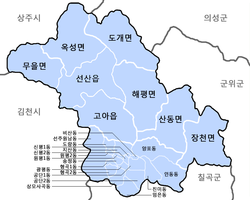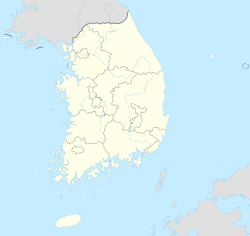Seonsan
Seonsan-eup | |
|---|---|
eup | |
| Korean transcription(s) | |
| • Hangul | 선산읍 |
| • Hanja | 善山邑 |
| • Revised Romanization | Seonsan-eup |
| • McCune–Reischauer | Sŏnsan-ŭp |
 | |
| Coordinates: 37°02′N 127°31′E / 37.033°N 127.517°E | |
| Country | South Korea |
| Province | North Gyeongsang Province |
| City | Gumi |
| Population (May 2022)[1] | |
• Total | Around 14,000 |
| Website | www |
Seonsan-eup (Korean: 선산읍), is an eup or large village in Gumi, North Gyeongsang, South Korea. It has an area of 69 km2. There are several historical landmarks in Seonsan, including two Joseon Dynasty schools: Geumo Seowon and the Seonsan hyanggyo. In addition, South Korean national treasure number 130, the five-storied pagoda of Jukjang-dong, is located there.[citation needed]
As of May 2022[update], the population was around 14,000.[1] This is a marked decline from past years; in 1995, its population had been 21,385. That number dropped to 15,001 by the end of 2020, and 14,623 by the end of 2021. The population is expected to continue dropping.[1]
History
[edit]The area has been populated for over a thousand years. In 614, it was part of Silla.[2] Seonsan was the site of the final battle between Goryeo and Later Baekje in 936, in which Later Baekje was finally defeated by the combined forces of Wang Kŏn and Kyŏn Hwŏn.[citation needed] It received its current name in 1413, during the early Joseon period. Around 1915, its population was around 1,000.[2]
Seonsan was raised from myeon to eup status in 1979.[2] Since 2004, it has been connected to the Jungbu Naeryuk Expressway.[citation needed]
Famous people associated with Seonsan include former South Korean president Park Chung Hee and early Joseon scholar Ha Wi-ji.[citation needed]
See also
[edit]References
[edit]- ^ a b c 백, 종현 (2022-05-30). "1만4천명선도 위협....구미시 선산읍, 충격적 인구 붕괴 계속". Yeongnam Ilbo (in Korean). Retrieved 2024-03-06.
- ^ a b c "선산(善山)". Encyclopedia of Korean Culture (in Korean). Retrieved 2024-03-06.

